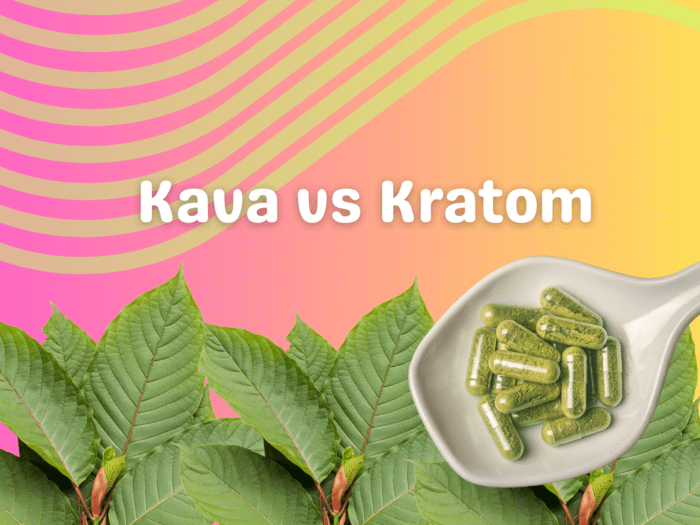Kava and kratom, two intriguing natural remedies, have emerged as potential solutions for a range of health concerns. Each herb has its unique benefits and controversies. In this article, we explore the world of kava and kratom, shedding light on their origins, uses, and the ongoing debate surrounding their safety and effectiveness. Whether you’re a seasoned enthusiast or just curious, join us as we explore these two herbal alternatives and provide insights to help you make informed choices.
What is Kava?
Kava, also known as “the root of relaxation,” is a traditional herbal beverage from the South Pacific, especially Fiji, Vanuatu, and Papua New Guinea. It’s made from the root of the kava plant (Piper methysticum) and has been used for centuries in these cultures. Kava’s active ingredients, called kavalactones, have calming and sedative effects, making it a popular social and ceremonial drink. Its unique combination of relaxation and mental clarity has led to growing interest in kava as a natural alternative for stress relief and relaxation around the world.
What is Kratom?
Kratom, a botanical marvel native to Southeast Asia, has been used for centuries as a traditional remedy. Indigenous to countries like Thailand, Indonesia, Malaysia, and Myanmar, kratom is an integral part of local cultures and folk medicine. Kratom’s primary active compounds, mitragynine and 7-hydroxymitragynine, interact with opioid receptors in the body, producing stimulating or sedative effects depending on the strain and dosage. This versatility has sparked a surge of interest outside its native regions, as people seek out kratom for its potential to alleviate pain, boost energy, or manage various health conditions.
Are there any similarities between Kava and Kratom?
While they come from different plant species and have distinct properties, they share several similarities:
Traditional Use
Kava
Kava has a long history of traditional use in the South Pacific, where it is consumed as a ceremonial and social beverage. It plays a central role in rituals and gatherings, promoting relaxation and sociability.
Kratom
Kratom has been used for centuries in Southeast Asia, primarily in countries like Thailand and Malaysia. It is employed as a traditional remedy to alleviate pain, increase energy, and manage various ailments.
Herbal Origin
Kava
Kava comes from the root of the kava plant, a native of the South Pacific islands.
Kratom
Kratom is made from the leaves of the kratom tree, which is indigenous to Southeast Asia.
Active Compounds
Kava
The active compounds in kava are kavalactones, which have sedative and anxiolytic (anxiety-reducing) properties. These compounds are responsible for the calming effects of kava.
Kratom
Kratom contains alkaloids like mitragynine and 7-hydroxymitragynine, which interact with opioid receptors in the body. This interaction can lead to varying effects, including pain relief and stimulation.

Potential Health Benefits
Kava
Kava is known for its potential to reduce stress and anxiety, promote relaxation, and improve sleep quality. Some studies suggest it may have mild analgesic (pain-relieving) properties.
Kratom
Kratom users have reported a range of effects, including pain relief, increased energy, mood enhancement, and relaxation. However, the effects can vary widely depending on the strain and dosage.
Controversy and Regulation
Both kava and kratom have faced regulatory scrutiny and controversy in various regions due to concerns about their safety and potential for misuse. Some countries and states have banned or restricted their sale and use.
Preparation and Consumption
Kava
Kava is typically prepared by extracting the active compounds from the kava root through methods like grinding, pounding, or blending the root, followed by steeping in water. It is consumed as a beverage.
Kratom
Kratom leaves are typically dried and ground into a powder, which can be consumed by mixing it with water, making tea, or encapsulating it in pill form.
Their usage should be approached with caution, and individuals considering their use should research thoroughly and consult with healthcare professionals. Additionally, the regulatory status of these substances varies by region, so it’s essential to be aware of local laws and regulations.
What are the differences?
Kava and kratom are distinct botanicals with notable differences in their origin, active compounds, effects, and potential for addiction:
Origin
Kava
Kava comes from the root of the kava plant (Piper methysticum), primarily found in the South Pacific islands.
Kratom
Kratom is derived from the leaves of the kratom tree (Mitragyna speciosa), native to Southeast Asia.
Active Compounds
Kava
The active compounds in kava are kavalactones, which have sedative and anxiolytic (anxiety-reducing) properties. They do not directly interact with opioid receptors.
Kratom
Kratom contains alkaloids, including mitragynine and 7-hydroxymitragynine, which interact with opioid receptors in the body, leading to various effects.
Effects
Kava
Kava is known for its relaxing and calming effects. It can reduce anxiety, promote sociability, and improve sleep. It is not typically associated with intense euphoria or sedation.
Kratom
Kratom effects can vary widely based on the strain and dosage. It can provide pain relief, increase energy, induce relaxation, or even produce euphoria, depending on the specific kratom variety used.
Addiction Potential
Kava
Kava is generally considered non-addictive, and there is limited evidence to suggest that it leads to physical dependence or withdrawal symptoms with responsible use. However, excessive or prolonged use may lead to tolerance and psychological dependence.
Kratom
Kratom has a higher potential for addiction and physical dependence, particularly when used in large amounts or over extended periods. Withdrawal symptoms such as anxiety, insomnia, muscle aches, and cravings have been reported among heavy users.
Regulatory Status
Kava
Kava has faced regulatory challenges in some countries due to concerns about potential liver toxicity. It has been banned or restricted in certain places, but it remains legal and widely consumed in others.
Kratom
The legal status of kratom varies widely by country and state. Some regions have banned or restricted its sale and use due to safety concerns and potential for abuse.
Cultural Significance
Kava
Kava holds cultural significance in the South Pacific, where it is used in ceremonies and social gatherings. It is deeply ingrained in the traditions of various island nations.
Kratom
Kratom has cultural importance in Southeast Asia, where it has been used as a traditional remedy for generations. It is not as deeply woven into local customs as kava in the South Pacific.
It is crucial for individuals to be well-informed about these differences and to use both substances responsibly and in accordance with local laws and regulations to minimize potential risks, including the risk of addiction.
Are Kava and Kratom safe?
The safety of kava and kratom is a topic of ongoing debate. Kava is generally safe when used in moderation, with a low risk of addiction or severe side effects. However, there have been rare cases of liver damage linked to heavy or prolonged kava use, which has led to some regulations in certain countries.
Kratom’s safety profile is more complex. While it has been used traditionally in Southeast Asia for centuries, there are concerns about its potential for addiction, dependence, and withdrawal symptoms, especially in people who use it excessively or in high doses. Kratom has also been linked to various side effects, such as nausea, dizziness, and digestive problems.
It is important to approach both kava and kratom with caution, follow recommended dosages, and seek guidance from a healthcare professional if needed. Additionally, the legal status of these substances varies by region, so it is important to be aware of local laws and regulations to ensure their safe and responsible use. Ultimately, individual experiences with these herbal remedies may vary, and any potential use should be weighed against the potential risks involved.
The Bottomline
When choosing between kava and kratom, it’s important to weigh the unique benefits and risks of each herbal remedy. Kava, a traditional South Pacific drink, offers relaxation and calm, while kratom, a plant native to Southeast Asia, has a variety of effects. Your choice should depend on your specific health goals and be made in accordance with local laws and regulations. Remember, responsible use and consultation with healthcare professionals are essential, as both options have their complexities and potential concerns. Ultimately, your path to holistic well-being should prioritize informed decisions and your individual needs.





